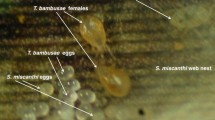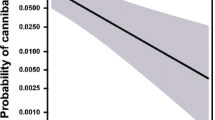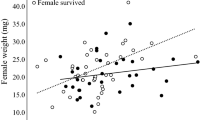Abstract
The fecundity benefit of sexual cannibalism is a key parameter of models for the evolution and population-level consequences of sexual cannibalism. Previous studies of praying mantids that have attempted to measure the change in egg production following cannibalism have yielded inconsistent results, possibility due to differences in female ages and background diets. We studied the effect of cannibalism on egg production and egg laying in the Chinese praying mantid (Tenodera sinensis), standardizing female age and mating status, and maintaining females on diets that reflect natural rates of foraging. We experimentally assigned females to one of three treatments: cannibal, non-cannibal, or cricket consumers that received an additional diet of crickets (Acheta domesticus) roughly equivalent to the mass consumed by cannibals. We show that cannibalistic females that consume multiple males produced significantly more eggs and laid more eggs in their first ootheca (egg case) compared to non-cannibals. This result supports the hypothesis that sexual cannibalism in T. sinensis is a female foraging strategy that provides resources to increase fecundity. The increase in egg production by cannibals was similar to that of the cricket consumer females suggesting that male mantids are equivalent to other prey, per unit body mass, in terms of their effects on egg production.


Similar content being viewed by others
Data Availability
Data are available on request.
Code Availability
Not applicable.
References
Arnqvist G, Henriksson S (1997) Sexual cannibalism in the fishing spider and a model for the evolution of sexual cannibalism based on genetic constraints. Evol Ecol 11:255–273
Barry KL, Holwell GI, Herberstein ME (2008) Female praying mantids use sexual cannibalism as a foraging strategy to increase fecundity. Behav Ecol 19:710–715
Barry KL, Kokko H (2010) Male mate choice: why sequential choice can make its evolution difficult. Anim Behav 80:163–169
Birkhead TR, Lee KE, Young P (1988) Sexual cannibalism in the praying mantis Hierodula membranacea. Behaviour 106:112–118
Boisseau RP, Wilder SM, Barry KL (2016) Sexual and nonsexual cannibalism have different effects on offspring performance in redback spiders. Behav Ecol 28:294–303
Brown WD, Barry KL (2016) Sexual cannibalism increases male material investment in offspring: quantifying terminal reproductive effort in a praying mantis. Proc R Soc B 283:20160656
Brown WD, Muntz GA, Ladowski AJ (2012) Low mate encounter rate increases male risk taking in a sexually cannibalistic praying mantis. PLoS ONE 7:e35377
Buskirk RE, Frohlich C, Ross KG (1984) The natural selection of sexual cannibalism. Am Nat 123:612–625
Christensen T, Brown WD (2018) Population structure, movement patterns, and frequency of multiple matings in Tenodera sinensis (Mantodea: Mantidae). Environ Entomol 47:676–683
Deventer SA, Herberstein ME, Mayntz D, O’Hanlon JC, Schneider JM (2017) Female fecundity and offspring survival are not increased through sexual cannibalism in the spider Larinioides sclopetarius. J Evol Biol 30:2146–2155
Eisenberg RM, Hurd LE, Bartley JA (1981) Ecological consequences of food limitation for adult mantids (Tenodera ardifolia sinensis Saussure). Am Midl Nat 106:209–218
Elgar MA (1992) Sexual cannibalism in spiders and other invertebrates. In: Cannibalism: ecology and evolution among diverse taxa. Oxford, New York. pp 128–155.
Elgar MA, Schneider JM (2004) Evolutionary significance of sexual cannibalism. Adv Behav 34:135–163
Fisher AM, Cornell SJ, Holwell GI, Price TA (2018) Sexual cannibalism and population viability. Ecol Evol 8:6663–6670
Fromhage L, Uhl G, Schneider JM (2003) Fitness consequences of sexual cannibalism in female Argiope bruennichi. Behav Ecol Sociobiol 55:60–64
Hurd LE, Eisenberg RM, Fagan WF, Tilmon KJ, Snyder WE, Vandersall KS, Datz SG, Welch JD (1994) Cannibalism reverses male-biased sex ratio in adult mantids: female strategy against food limitation? Oikos 69:193–198
Jakob EM, Marshall SD, Uetz GW (1996) Estimating fitness: a comparison of body condition indices. Oikos 77:61–67
Johnson JC, Sih A (2005) Precopulatory sexual cannibalism in fishing spiders (Dolomedes triton): a role for behavioral syndromes. Behav Ecol Sociobiol 58:390–396
Lawrence SE (1992) Sexual cannibalism in the praying mantid Mantis religiosa: a field study. Anim Behav 43:569–583
Lelito JP, Brown WD (2006) Complicity or conflict over sexual cannibalism? Male risk taking in the praying mantis Tenodera aridifolia sinensis. Am Nat 168:263–269
Lelito JP, Brown WD (2008) Mate attraction by females in a sexually cannibalistic praying mantis. Behav Ecol Sociobiol 63:313–320
Lihoreau M, Buhl J, Charleston MA, Sword GA, Raubenheimer D, Simpson SJ (2015) Nutritional ecology beyond the individual: a conceptual framework for integrating nutrition and social interactions. Ecol Letters 18:273–286
Liske E, Davis WJ (1987) Courtship and mating behaviour of the Chinese praying manits Tenodera aridifolia sinensis. Anim Behav 35:1524–1537
Maxwell MR (2000) Does a single meal affect female reproductive output in the sexually cannibalistic praying mantid Iris oratoria? Ecol Entomol 25:54–62
Maxwell MR, Gallego KM, Barry KL (2010) Effects of female feeding regime in a sexually cannibalistic mantid: fecundity, cannibalism, and male response in Stagmomantis limbata (Mantodea). Ecol Entomol 35:775–787
Newman JA, Elgar MA (1991) Sexual cannibalism in orb-weaving spiders: an economic model. Am Nat 138:1372–1395
Polis GA (1981) The evolution and dynamics of intraspecific predation. Annu Rev Ecol Systemat 12:225–251
Prenter J, MacNeil C, Elwood RW (2006) Sexual cannibalism and mate choice. Anim Behav 71:481–490
Rabaneda-Bueno R, Rodriguez-Girones MA, Aguado-de-la-Paz S, Ferandez-Montraveta C, De Mas E, Wise DH, Moya-Larano J (2008) Sexual cannibalism: high incidence in a natural population with benefits to females. PLoS ONE 3:e3484
Rathet IH, Hurd LE (1983) Ecological relationships of three co-occurring mantids Tenodera sinensis (Saussure), T angustipennis (Saussure), and Mantis religiosa (Linnaeus). Am Midl Nat 110:240–248
Sage RD (1982) Wet and dry-weight estimates of insects and spiders based on length. Am Midl Nat 108:407–411
Schwartz SK, Wagner WE Jr, Hebets EA (2016) Males can benefit from sexual cannibalism facilitated by self-sacrifice. Curr Biol 26:2794–2799
Walker LA, Holwell GI (2015) Sexual cannibalism in a facultative parthenogen: the springbok mantis (Miomantis caffra). Behav Ecol 27:851–856
Welke KW, Schneider JM (2012) Sexual cannibalism benefits offspring survival. Anim Behav 83:201–207
Wilder SM, Rypstra AL (2010) Males make poor meals: a comparison of nutrient extraction during sexual cannibalism and predation. Oecologia 162:617–625
Wu L, Zhang H, He T, Liu Z, Peng Y (2013) Factors influencing sexual cannibalism and its benefit to fecundity and offspring survival in the wolf spider Pardosa pseudoannulata (Araneae: Lycosidae). Behav Ecol Sociobio 67:205–212
Acknowledgements
We would like to thank T. Lee and S.B. Ferguson for comments on an earlier draft of the manuscript. This work was funded by Sigma-Xi Grants in Aid of Research (GIAR) and the Falcone Endowment.
Funding
This work was funded by Sigma-Xi Grants in Aid of Research (GIAR) and the Falcone Endowment.
Author information
Authors and Affiliations
Corresponding author
Ethics declarations
Ethics Approval
Not applicable.
Consent to Participate
Not applicable.
Consent for Publication
Not applicable.
Conflicts of Interest/Competing Interests
Not applicable.
Additional information
Publisher's Note
Springer Nature remains neutral with regard to jurisdictional claims in published maps and institutional affiliations.
Rights and permissions
About this article
Cite this article
O’Hara, M.K., Brown, W.D. Sexual Cannibalism Increases Female Egg Production in the Chinese Praying Mantid (Tenodera sinensis). J Insect Behav 34, 127–135 (2021). https://doi.org/10.1007/s10905-021-09776-y
Received:
Revised:
Accepted:
Published:
Issue Date:
DOI: https://doi.org/10.1007/s10905-021-09776-y




